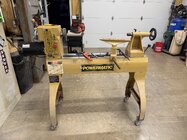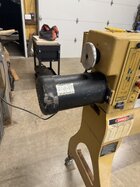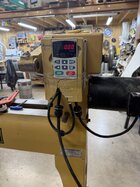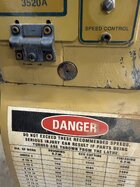Ok so here's the deal. I found a PM3520A on the facebook for $500 and thought I would go take a look. Turns out the thing had been dropped or knocked over and the VFD shell was torn up and the motor was not on the thing. I started to test the motor and all posts showed continuity so I thought it was fried. I then started looking at bearings and all of the controls. The speed control know is broken off and the on/off was a little cockeyed.
We got into the negotiations and of course I started pointing out all of the things that were wrong and missing. He said throw me a number... I started at $200 and he said $350. I hit back with $300 and he said take it and get it out of his shop. I got home off loaded it and starting cleaning up the ways. They cleaned up perfectly so I started cleaning all of the mating surfaces. As I started to put the headstock, banjo and quill on I noticed the tensioning rod that cranks down the headstock was broke so I tabbed one up and called that part done. Once I cranked the head down I noted a little crack on the headstock right around the rod. I guess I will get that repaired later, if everything fires up.
I rewired everything and got the motor mounted with some longer hex head bolts. I started by just hooking up the VFD and controls to make sure it fired up. As beat up as the housing was the VFD showed signs of life by illuminating the LCD. I reached around the pulled the switch, sure enough it showed run. I then cycled the FWD RV knob and all of that regestistered. Then I turned what was left of the speed control knob and it worked too. I thought surely this $300 deal I just got couldn't get better.
I wired in the motor figuring I would need to get it rebuilt, but no. Fired right up.
I am totally shook and shocked that it worked.
I threw a heavy faceplate on to see if anything gave me fits and the only things was an OV code when I turned the speed down to fast. I switched belts from speed to torque and the error does not reappear. Y'all think I should install a brake resistor?
Let me know the best place to find a new VFD housing (perhaps one of you have a burned up one laying around I can swap the good parts into) and a good spot to find the speed control knob.
We got into the negotiations and of course I started pointing out all of the things that were wrong and missing. He said throw me a number... I started at $200 and he said $350. I hit back with $300 and he said take it and get it out of his shop. I got home off loaded it and starting cleaning up the ways. They cleaned up perfectly so I started cleaning all of the mating surfaces. As I started to put the headstock, banjo and quill on I noticed the tensioning rod that cranks down the headstock was broke so I tabbed one up and called that part done. Once I cranked the head down I noted a little crack on the headstock right around the rod. I guess I will get that repaired later, if everything fires up.
I rewired everything and got the motor mounted with some longer hex head bolts. I started by just hooking up the VFD and controls to make sure it fired up. As beat up as the housing was the VFD showed signs of life by illuminating the LCD. I reached around the pulled the switch, sure enough it showed run. I then cycled the FWD RV knob and all of that regestistered. Then I turned what was left of the speed control knob and it worked too. I thought surely this $300 deal I just got couldn't get better.
I wired in the motor figuring I would need to get it rebuilt, but no. Fired right up.
I am totally shook and shocked that it worked.
I threw a heavy faceplate on to see if anything gave me fits and the only things was an OV code when I turned the speed down to fast. I switched belts from speed to torque and the error does not reappear. Y'all think I should install a brake resistor?
Let me know the best place to find a new VFD housing (perhaps one of you have a burned up one laying around I can swap the good parts into) and a good spot to find the speed control knob.






